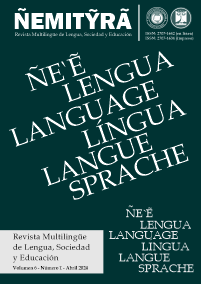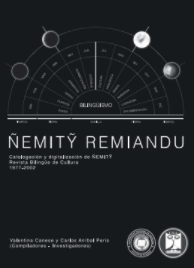Student Task Engagement in Remote Language Learning During the Pandemic: Perspectives and Experiences of Junior High School English Teachers
DOI:
https://doi.org/10.47133/NEMITYRA20240601-A4Palabras clave:
challenges, experiences, facilitators, language learning, perspectives, remote instruction, Student task engagementResumen
The level of participation and involvement of students in their learning activities, student task engagement, is regarded as one of the essential conditions for success in language learning. The main objective of this qualitative study was to explore how junior high school English teachers approach student task engagement in a remote language learning context during the COVID-19 pandemic. For this reason, a focus group and individual interviews were conducted with English teachers from a private school in Asunción. Results indicated that they had well-defined perspectives concerning student task engagement in language learning, and they reported using varied strategies, activities, and resources as well as facing several challenges in the design and implementation of learning tasks in their efforts to promote language task engagement in remote classes. From their statements, it can be concluded that their beliefs directed their teaching practices in times of remote instruction, but they could not avoid encountering challenges of different nature that hindered the integration of engagement facilitators into learning tasks in order to foster student task engagement.
Referencias
Ainley, M. (2012). Students’ Interest and Engagement in Classroom Activities. In S. L. Christenson, A. L. Reschly, & C. Wylie (Eds.), Handbook of Research on Student Engagement (pp. 21–44). Springer US.
Atmojo, A. E. P., & Nugroho, A. (2020). EFL Classes Must Go Online! Teaching Activities and Challenges during COVID-19 Pandemic in Indonesia. Register Journal, 13(1), 49–76. Retrieved July 27, 2021, from https://journalregister.iainsalatiga.ac.id/index.php/register/article/view/4051
Berry, A. E. (2019). THE PEDAGOGY OF ENGAGEMENT: CLASSROOM MANAGEMENT VS. FACILITATING LEARNING (Doctoral Dissertation). The University of Melbourne. Retrieved June 16, 2021, from http://hdl.handle.net/11343/230712
Boling, E. C., Hough, M., Krinsky, H., Saleem, H., & Stevens, M. (2012). Cutting the distance in distance education: Perspectives on what promotes positive, online learning experiences. The Internet and Higher Education, 15(2), 118–126. Retrieved May 29, 2021, from https://linkinghub.elsevier.com/retrieve/pii/S109675161100090X
Callegaro, M. (2008). Social Desirability. In P. J. Lavrakas (Ed.), Encyclopedia of survey research methods (Vol. 2, p. 825). Thousand Oaks, California: SAGE Publications.
Carr, M. (2014). The Online University Classroom: One Perspective for Effective Student Engagement and Teaching in an Online Environment. Journal of Effective Teaching, 14(1), 99–110. Retrieved July 30, 2021, from https://files.eric.ed.gov/fulltext/EJ1060450.pdf
Chakraborty, M., & Muyia Nafukho, F. (2014). Strengthening student engagement: What do students want in online courses? European Journal of Training and Development, 38(9), 782–802. Retrieved August 12, 2021, from https://www.emerald.com/insight/content/doi/10.1108/EJTD-11-2013-0123/full/html
Christenson, S. L., Reschly, A. L., & Wylie, C. (Eds.). (2012). Handbook of Research on Student Engagement. Boston, MA: Springer US.
Creswell, J. W. (2014). Educational research: Planning, conducting and evaluating quantitative and qualitative research (Pearson new international edition, 4th edition). Harlow, Essex: Pearson.
Creswell, J. W., & Creswell, J. D. (2018). Research Design: Qualitative, Quantitative, and Mixed Methods Approaches (Fifth Edition). Thousand Oaks, CA: SAGE Publications, Inc.
Creswell, J. W., & Plano Clark, V. L. (2018). Designing and Conducting Mixed Methods Research (3rd ed.). Thousand Oaks, CA: SAGE Publications, Inc.
Crick, R. D. (2012). Deep Engagement as a Complex System: Identity, Learning Power and Authentic Enquiry. In S. L. Christenson, A. L. Reschly, & C. Wylie (Eds.), Handbook of Research on Student Engagement (pp. 675–694). Boston, MA: Springer US.
De La Rosa, S. (2020, September 9). Student engagement remains a challenge in distance learning. Retrieved June 28, 2021, from https://www.k12dive.com/news/student-engagement-remains-a-challenge-in-distance-learning/584793/
Dempsey, M., & Burke, J. (2021). Lessons Learned: The experiences of teachers in Ireland during the 2020 pandemic. (pp. 1-104). Maynooth: Maynooth University.
Denning, C. B., Acar, S., Sharicz, C., & Foust, E. (2021). Reimagining Student Engagement in the Remote Classroom Environment. Pedagogy and the Human Sciences, 8(1), 1–25. Retrieved November 5, from https://scholarworks.merrimack.edu/phs/vol8/iss1/1
EDUCAUSE. (2020). 7 Things You Should Know About the HyFlex Course Model. Retrieved July 14, 2021, from https://library.educause.edu/-/media/files/library/2020/7/eli7173.pdf
Egbert, J. (2020a). Engagement, Technology, and Language Tasks: Optimizing Student Learning. International Journal of TESOL Studies. Retrieved March 12, 2021, from https://www.tesolunion.org/attachments/files/9NWRI5OGIY4ZTHHAZJY1AM2VI0ZDC38NTKX8ODVH0YWZJANMEX8ZWVI0NMMW9NTYY0NDVM2ZTQ5AYJCW8ZTVK6ZMEX2LJI48NZU40MJUZDLMVL.pdf
Egbert, J. (2020b). The new normal?: A pandemic of task engagement in language learning. Foreign Language Annals, 53(2), 314–319. Retrieved April 21, 2021, from https://onlinelibrary.wiley.com/doi/abs/10.1111/flan.12452
Egbert, J. (2020c). TASK ENGAGEMENT AS A FACILITATOR OF ACHIEVEMENT IN (LANGUAGE) LEARNING. PROCEEDINGS OF THE ESIDRP INTERNATIONAL CONFERENCE, 21ST – 23RD MARCH 2019, 2–13. Retrieved April 19, 2021, from https://flf.ukim.mk/wp-content/uploads/2020/06/ESIDRP2019.pdf
Egbert, J. (n.d.). Language Task Engagement (Theory) – Theoretical Models for Teaching and Research. Retrieved May 6, 2021, from https://opentext.wsu.edu/theoreticalmodelsforteachingandresearch/chapter/language-task-engagement-theory/
Egbert, J., & Chia Chang, A. (2018). Engagement in CALL. In J. I. Liontas & M. DelliCarpini (Eds.), The TESOL Encyclopedia of English Language Teaching (1st ed., pp. 1–7). Hoboken, NJ, USA: John Wiley & Sons, Inc. Retrieved April 24, 2021, from https://doi.org/10.1002/9781118784235.eelt0407
Egbert, J. L., Abobaker, R., Bekar, M., Shahrokni, S. A., Bantawtook, P., Roe, M. F., … Huh, K. (2021). Language Task Engagement: An Evidence-Based Model. TESL-EJ, 24(4), 1–34. Retrieved April 3, 2021, from https://tesl-ej.org/pdf/ej96/a3.pdf
Egbert, J., Shahrokni, S. A., Abobaker, R., & Borysenko, N. (2021). “It’s a chance to make mistakes”: Processes and outcomes of coding in 2nd grade classrooms. Computers & Education, 168, 104173. Retrieved July 8, 2021, from https://linkinghub.elsevier.com/retrieve/pii/S0360131521000506
Egbert, J., Shahrokni, S. A., He, H., & Bantawtook, P. (2020, April 15). Theoretical Model of Language Task Engagement | Showcase 2021 | Washington State University. Retrieved May 22, 2021, from https://showcase.wsu.edu/2020/04/15/theoretical-model-of-language-task-engagement/
Finn, J. D. (1989). Withdrawing From School. Review of Educational Research, 59(2), 117–142. Retrieved April 17, 2021, from https://journals.sagepub.com/doi/10.3102/00346543059002117
Finn, J. D., & Zimmer, K. S. (2012). Student Engagement: What Is It? Why Does It Matter? In S. L. Christenson, A. L. Reschly, & C. Wylie (Eds.), Handbook of Research on Student Engagement (pp. 97–132). Boston, MA: Springer US.
Frechtling, J. (2002). The 2002 User Friendly Handbook for Project Evaluation. The National Science Foundation. Retrieved May 2, 2021, from https://www.nsf.gov/pubs/2002/nsf02057/nsf02057.pdf
Fredricks, J. A. (2016). Student engagement, context, and adjustment: Addressing definitional, measurement, and methodological issues. Learning and Instruction, 43, 1–4. Retrieved March 21, 2021, from https://www.sciencedirect.com/science/article/abs/pii/S0959475216300159
Fredricks, J. A., Blumenfeld, P. C., & Paris, A. H. (2004). School Engagement: Potential of the Concept, State of the Evidence. Review of Educational Research, 74(1), 59–109. Retrieved March 3, 2021, from http://www.jstor.org/stable/3516061
Fredricks, J. A., & McColskey, W. (2012). The Measurement of Student Engagement: A Comparative Analysis of Various Methods and Student Self-report Instruments. In S. L. Christenson, A. L. Reschly, & C. Wylie (Eds.), Handbook of Research on Student Engagement (pp. 763–782). Boston, MA: Springer US.
Fredricks, J. A., Reschly, A. L., & Christenson, S. L. (2019). Interventions for Student Engagement: Overview and State of the Field. In J. A. Fredricks, A. L. Reschly, & S. L. Christenson (Eds.), Handbook of Student Engagement Interventions (pp. 1–11). Academic Press.
Fredricks, J. A., Wang, M.-T., Linn, J. S., Hofkens, T. L., Sung, H., Parr, A., & Allerton, J. (2016). Using qualitative methods to develop a survey measure of math and science engagement. Learning and Instruction, 43, 5–15. Retrieved March 29, 2021, from https://linkinghub.elsevier.com/retrieve/pii/S0959475216300093
Geneva College. (2020, April 20). Online vs Remote Learning. Retrieved December 17, 2021, from https://www.geneva.edu/blog/higher-education/online-education-vs-remote-learning
Gobert, J. D., Baker, R. S., & Wixon, M. B. (2015). Operationalizing and Detecting Disengagement Within Online Science Microworlds. Educational Psychologist, 50(1), 43–57. Retrieved June 12, 2021, from http://www.tandfonline.com/doi/abs/10.1080/00461520.2014.999919
Harbour, K. E., Evanovich, L. L., Sweigart, C. A., & Hughes, L. E. (2015). A Brief Review of Effective Teaching Practices That Maximize Student Engagement. Preventing School Failure: Alternative Education for Children and Youth, 59(1), 5–13. Retrieved May 5, 2021, from http://www.tandfonline.com/doi/abs/10.1080/1045988X.2014.919136
Harris, L. R. (2008). A phenomenographic investigation of teacher conceptions of student engagement in learning. The Australian Educational Researcher, 35(1), 57–79. Retrieved July 8, 2021, from http://link.springer.com/10.1007/BF03216875
Harris, L. (2010). Delivering, modifying or collaborating? Examining three teacher conceptions of how to facilitate student engagement. Teachers and Teaching, 16(1), 131–151. Retrieved July 8, 2021, from https://www.tandfonline.com/doi/full/10.1080/13540600903478037
Harris, L. (2011). Secondary teachers’ conceptions of student engagement: Engagement in learning or in schooling? Teaching and Teacher Education, 27(2), 376–386. Retrieved July 8, 2021, from https://linkinghub.elsevier.com/retrieve/pii/S0742051X10001575
Hill, K., & Fitzgerald, R. (2020). Student Perspectives on the Impact of COVID-19 on Learning. All Ireland Journal of Higher Education, 12(2), 9. Retrieved July 23, 2021, from https://ojs.aishe.org/index.php/aishe-j/article/view/459
Hiver, P., Al-Hoorie, A. H., & Mercer, S. (Eds.). (2021). Student Engagement in the Language Classroom. Bristol, UK: Multilingual Matters. Retrieved June 11, 2021, from https://books.google.com.py/books?id=RqMJEAAAQBAJ&printsec=frontcover#v=onepage&q&f=false
Hofkens, T. L., & Ruzek, E. (2019). Measuring Student Engagement to Inform Effective Interventions in Schools. In J. A. Fredricks, A. L. Reschly, & S. L. Christenson (Eds.), Handbook of Student Engagement Interventions (pp. 309–324). Academic Press. Retrieved July 2, 2021, from https://www.sciencedirect.com/science/article/pii/B9780128134139000218
Jeong, K.-O. (2019). Online Collaborative Language Learning for Enhancing Learner Motivation and Classroom Engagement. International Journal of Contents, 15(4), 89–96. Retrieved August 3, 2021, from https://doi.org/10.5392/IJOC.2019.15.4.089
Khlaif, Z. N., Salha, S., & Kouraichi, B. (2021). Emergency remote learning during COVID-19 crisis: Students’ engagement. Education and Information Technologies. Retrieved August 13, 2021, from https://link.springer.com/10.1007/s10639-021-10566-4
Kingsbury, I. (2021). Online learning: How do brick and mortar schools stack up to virtual schools? Education and Information Technologies. Retrieved April 2, 2021, from http://link.springer.com/10.1007/s10639-021-10450-1
Kolesnikova, A. (2021). Lessons from the COVID-19 Pandemic: Boosting Student Engagement. Russian Language Journal, 71(2), 195–210. Retrieved November 1, from https://scholarsarchive.byu.edu/rlj/vol71/iss2/10
Liu, C.-C., Wang, P.-C., & Tai, S.-J. D. (2016). An analysis of student engagement patterns in language learning facilitated by Web 2.0 technologies. ReCALL, 28(2), 104–122. Retrieved April 19, 2021, from https://www.cambridge.org/core/product/identifier/S095834401600001X/type/journal_article
Lodico, M. G., Spaulding, D. T., & Voegtle, K. H. (2010). Methods in Educational Research: From Theory to Practice, Second Edition. San Francisco, CA: Jossey-Bass, A Wiley Imprint.
Mandernach, B. J. (2009). Three Ways to Improve Student Engagement in the Online Classroom. Online Classroom, 3, 1–2. Retrieved July 30, 2021, from http://augmenting.me/cte/resources/newsletters_archive/OC0903.pdf
Martín-Sómer, M., Moreira, J., & Casado, C. (2021). Use of Kahoot! To keep students’ motivation during online classes in the lockdown period caused by Covid 19. Education for Chemical Engineers, 36, 154–159. Retrieved October 30, 2021, from https://doi.org/10.1016/j.ece.2021.05.005
Mercer, S. (2019). Language Learner Engagement: Setting the Scene. In X. Gao (Ed.), Second Handbook of English Language Teaching (pp. 643–660). Cham: Springer International Publishing.
Mercer, S., & Dörnyei, Z. (2020). Engaging Language Learners in Contemporary Classrooms. Cambridge University Press. Retrieved March 23, 2021, from https://books.google.com.py/books?id=PffnDwAAQBAJ
Nartiningrum, N., & Nugroho, A. (2020). Online Learning amidst Global Pandemic: EFL Students’ Challenges, Suggestions, and Needed Materials. ENGLISH FRANCA : Academic Journal of English Language and Education, 4(2), 115. Retrieved October 29, 2021, from http://journal.iaincurup.ac.id/index.php/english/article/view/1494
Oga-Baldwin, W. L. Q. (2019). Acting, thinking, feeling, making, collaborating: The engagement process in foreign language learning. System, 86, 102128. Retrieved April 2, 2021, from https://linkinghub.elsevier.com/retrieve/pii/S0346251X19301368
Patton, M. Q. (2015). Qualitative research & evaluation methods: Integrating theory and practice (Fourth edition). Thousand Oaks, California: SAGE Publications, Inc.
Philp, J., & Duchesne, S. (2016). Exploring Engagement in Tasks in the Language Classroom. Annual Review of Applied Linguistics, 36, 50–72. Retrieved June 5, 2021, from https://www.cambridge.org/core/product/identifier/S0267190515000094/type/journal_article
Reeve, J., & Tseng, C.-M. (2011). Agency as a fourth aspect of students’ engagement during learning activities. Contemporary Educational Psychology, 36(4), 257–267. Retrieved May 30, 2021, from https://linkinghub.elsevier.com/retrieve/pii/S0361476X11000191
Reschly, A. L., & Christenson, S. L. (2012). Jingle, Jangle, and Conceptual Haziness: Evolution and Future Directions of the Engagement Construct. In S. L. Christenson, A. L. Reschly, & C. Wylie (Eds.), Handbook of Research on Student Engagement (pp. 3–20). Boston, MA: Springer US.
Robinson, C. C., & Hullinger, H. (2008). New Benchmarks in Higher Education: Student Engagement in Online Learning. Journal of Education for Business, 84(2), 101–109. Retrieved July 17, 2021, from http://www.tandfonline.com/doi/abs/10.3200/JOEB.84.2.101-109
Sang, Y., & Hiver, P. (2021). Engagement and Companion Constructs in Language Learning: Conceptualizing Learners’ Involvement in the L2 Classroom. In P. Hiver, A. H. Al-Hoorie, & S. Mercer (Eds.), Student Engagement in the Language Classroom (pp. 17–37). Bristol, Blue Ridge Summit: Multilingual Matters. Retrieved May 14, 2021, from https://www.degruyter.com/document/doi/10.21832/9781788923613-005/pdf
Sarginson, D., & McPherson, S. (2021). Nearpod: An Innovative Teaching Strategy to Engage Students in Pathophysiology/ Pharmacology. Journal of Nursing Education, 60(7), 422–423. Retrieved October 30, from http://journals.healio.com/doi/10.3928/01484834-20210616-13
Seidman, I. (2006). Interviewing as qualitative research: A guide for researchers in education and the social sciences (3rd ed). New York: Teachers College Press.
Sivachenko, O., & Nedashkivska, A. (2021). Student Engagement in a Remote Language Learning Environment: The Case of Ukrainian. Russian Language Journal, 71(2), 57–72. Retrieved December 12, 2021, from https://scholarsarchive.byu.edu/rlj/vol71/iss2/4
Skinner, E. A., & Pitzer, J. R. (2012). Developmental Dynamics of Student Engagement, Coping, and Everyday Resilience. In S. L. Christenson, A. L. Reschly, & C. Wylie (Eds.), Handbook of Research on Student Engagement (pp. 21–44). Boston, MA: Springer US.
Stott, P. (2016). The perils of a lack of student engagement: Reflections of a “lonely, brave, and rather exposed” online instructor: The perils of a lack of engagement. British Journal of Educational Technology, 47(1), 51–64. Retrieved July 18, 2021, from http://doi.wiley.com/10.1111/bjet.12215
Trinidad, J. E. (2021). Equity, engagement, and health: School organisational issues and priorities during COVID-19. Journal of Educational Administration and History, 53(1), 67–80. Retrieved August 3, 2021, from https://www.tandfonline.com/doi/full/10.1080/00220620.2020.1858764
Valizadeh, M. (2021). Integration of Technology in EFL Classrooms: Turkish Teachers’ Perceptions. Turkish Online Journal of English Language Teaching (TOJELT), 6(2), 106–124. Retrieved November 5, from http://www.tojelt.com/Makaleler/1506304511_4-valizadeh%20n.pdf
Wang, M.-T., & Fredricks, J. A. (2014). The Reciprocal Links Between School Engagement, Youth Problem Behaviors, and School Dropout During Adolescence. Child Development, 85(2), 722–737. Retrieved June 22, 2021, from https://onlinelibrary.wiley.com/doi/10.1111/cdev.12138
Woo, M., Chu, S., Ho, A., & Li, X. (2011). Using a Wiki to Scaffold Primary-School Students’ Collaborative Writing. Educational Technology & Society, 14(1), 43–54. Retrieved August 19, 2021, from http://www.jstor.org/stable/jeductechsoci.14.1.43
Yazzie-Mintz, E. (2007). Voices of Students on Engagement: A Report on the 2006 High School Survey of Student Engagement. Center for Evaluation and Education Policy, Indiana University. Retrieved April 5, 2021, from https://files.eric.ed.gov/fulltext/ED495758.pdf
Zhang, K., Wu, S., Xu, Y., Cao, W., Goetz, T., & Parks-Stamm, E. J. (2021). Adaptability Promotes Student Engagement Under COVID-19: The Multiple Mediating Effects of Academic Emotion. Frontiers in Psychology, 11, 633265. Retrieved July 8, 2021, from https://www.frontiersin.org/articles/10.3389/fpsyg.2020.633265/full
Zhou, S., Hiver, P., & Al-Hoorie, A. H. (2021). 5 Measuring L2 Engagement: A Review of Issues and Applications: In P. Hiver, A. H. Al-Hoorie, & S. Mercer (Eds.), Student Engagement in the Language Classroom (pp. 75–98). Bristol, Blue Ridge Summit: Multilingual Matters. Retrieved May 29, 2021, from https://www.degruyter.com/document/doi/10.21832/9781788923613-008/html
Publicado
Número
Sección
Licencia
Derechos de autor 2024 Luis Enrique González Muñoz; Valentina Canese; y Revista Ñemitỹrã

Esta obra está bajo una licencia internacional Creative Commons Atribución 4.0.










